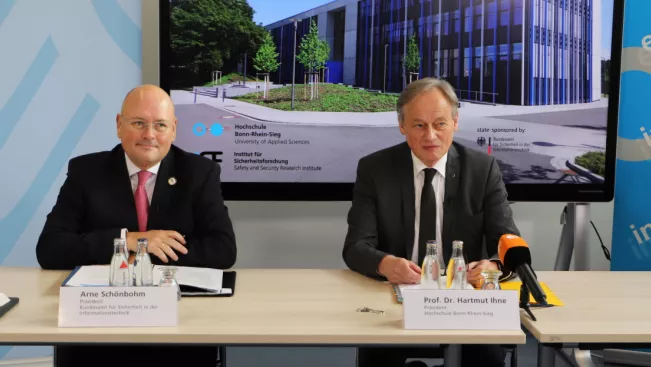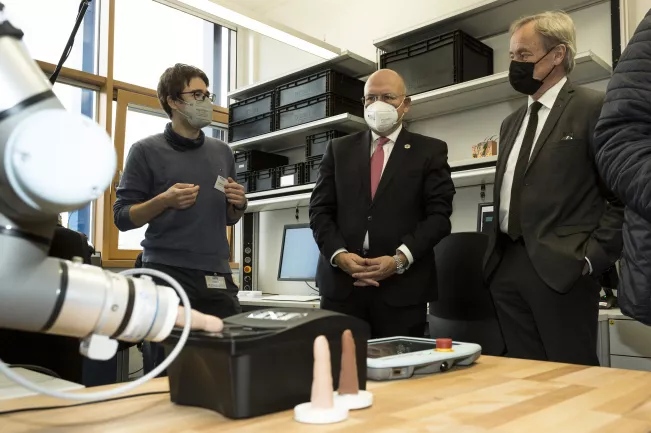Kommunikation und Marketing
H-BRS and BSI open the Biometric Evaluation Centre
Whether used for border checks or paying by smartphone: biometric systems are an important tool for authenticating users. With the onward march of digitalisation and the automation of ever more processes, the significance of biometrics will only increase further. At the same time, demands on reliability and security are becoming more stringent. Over the past three years, the Institute of Safety and Security Research (ISF) of Hochschule Bonn-Rhein-Sieg (H-BRS) has been collaborating with the German Federal Office for Information Security (BSI) to set up the Biometric Evaluation Centre (BEZ), which aims to improve biometric systems and enhance their security.

A familiar situation for many passengers who enter or leave the European Union by plane is that they are first required to place their passport face-down on an automatic checkpoint at an “e-gate” so it can be read electronically. In the next step, a photo is taken that the system compares with the digital photo from the document in a matter of seconds in its neuronal network. If it detects a match and verifies the passenger, it opens the gate.
With the rise of the smartphone, the same principle has become a common tool in ever more areas of everyday life. Instead of PINs and passwords, simple and rapid authentication using the user’s own fingerprint or face has become increasingly popular, enabling us to unlock our smartphones and authenticate ourselves to apps for shopping, online-banking or e-government applications, for instance. As the potential damage such applications can cause rises, so too do the demands on biometrics in terms of reliability and security against circumvention to prevent abuse.

The specific challenge facing this technology is that, whether you are certifying security or developing new sensors and processes, a biometric system always needs to be re-evaluated on as many people as possible and using extensive penetration tests whenever any software or hardware is modified. The stricter the security requirements, the more testing is required. To date, this has been the biggest obstacle both for security authorities and research institutes as there are few opportunities on offer where such tests can be performed. By setting up the Biometric Evaluation Centre (BEZ) and the “BIOLAB” project, Hochschule Bonn-Rhein-Sieg (H-BRS) and the German Federal Office for Information Security (BSI) have joined forces to tackle this challenge jointly and thoroughly.
Bridge between research and practice
The aim of the BEZ is to operate continual evaluation processes for testing biometric systems, including for applications in the public sector, in conjunction with applied research on the same site, and consequently to build a direct bridge between practical demands and new developments that improve biometric systems.
For example, the BEZ is home to multiple e-gates that are regularly evaluated by the BSI. The H-BRS researchers can flexibly enhance one of these gates with new biometric and anti-forgery technologies and compare it with the others. Using sensor technology developed by H-BRS, they can determine, for example, whether a material is skin or something else.
Similarly, new 3D cameras are examined to assess their suitability for verifying faces and especially for detecting forgeries. A direct comparison with the current status of technology means that quicker, optimal advances in security technologies can be made.

Fingerprints are recorded in 3D
Additionally, a person’s fingerprint is unique, making it a key feature for authentication. In the “3D Finger” project (which this year was selected as April’s project of the month by the German Federal Ministry of Education and Research), the biometric experts are developing a device that can record three-dimensional fingerprints. Because it can also register lower-lying skin structures, the 3D prints are extremely difficult to forge. In addition to security against circumvention, key aspects of this authentication include reliability and user-friendliness. The new system performs a complete analysis of the scanned fingerprints within 1.6 seconds. Data quantities of up to eight gigabytes are mobilised during that time – that’s the size of a DVD with 90-minute feature film.
The collaboration between H-BRS and BSI is as unusual as it is forward-looking. “The Biometric Evaluation Centre is an important example of a strategic alliance between the university and not only the BSI, but also broader society and the business community to make sure that processes of advancing digitalisation are managed in a safe and secure way,” said President of the University Hartmut Ihne.
Public-sector systems need to meet the highest standards
“The Biometrics Evaluation Centre shows what’s possible when research and practice are brought together. The scientific excellence of H-BRS meets the experts of the German government’s cyber-security authority, which has an overview of the many requirements of German, European and international public authorities and partners. Public-sector systems require intensive testing and safeguarding. They need to meet the highest standards. In that context, it is clear that information security is the prerequisite for a secure and successful process of digitalisation,” said BSI President Arne Schönbohm. The partnership between H-BRS, BSI and multiple manufacturers of biometric systems has been tried and tested since 2009 through multiple research and development projects. The BSI handles all aspects of data protection and secure data processing, which enables an especially high degree of GDPR compliance and reliability at the BEZ.
The aim is for the BEZ to become established as a manufacturer-independent authority for users, manufacturers and certification bodies. Further key factors are the interlinking of research and teaching as well as the involvement of the public. “There should be a close connection between research and teaching, from projects and dissertations through to doctoral theses,” said H-BRS project manager Professor Norbert Jung. “We have very direct lines of communication between theoretical and applied research.” When new issues and requirements arise, they can be quickly tackled in the BEZ.